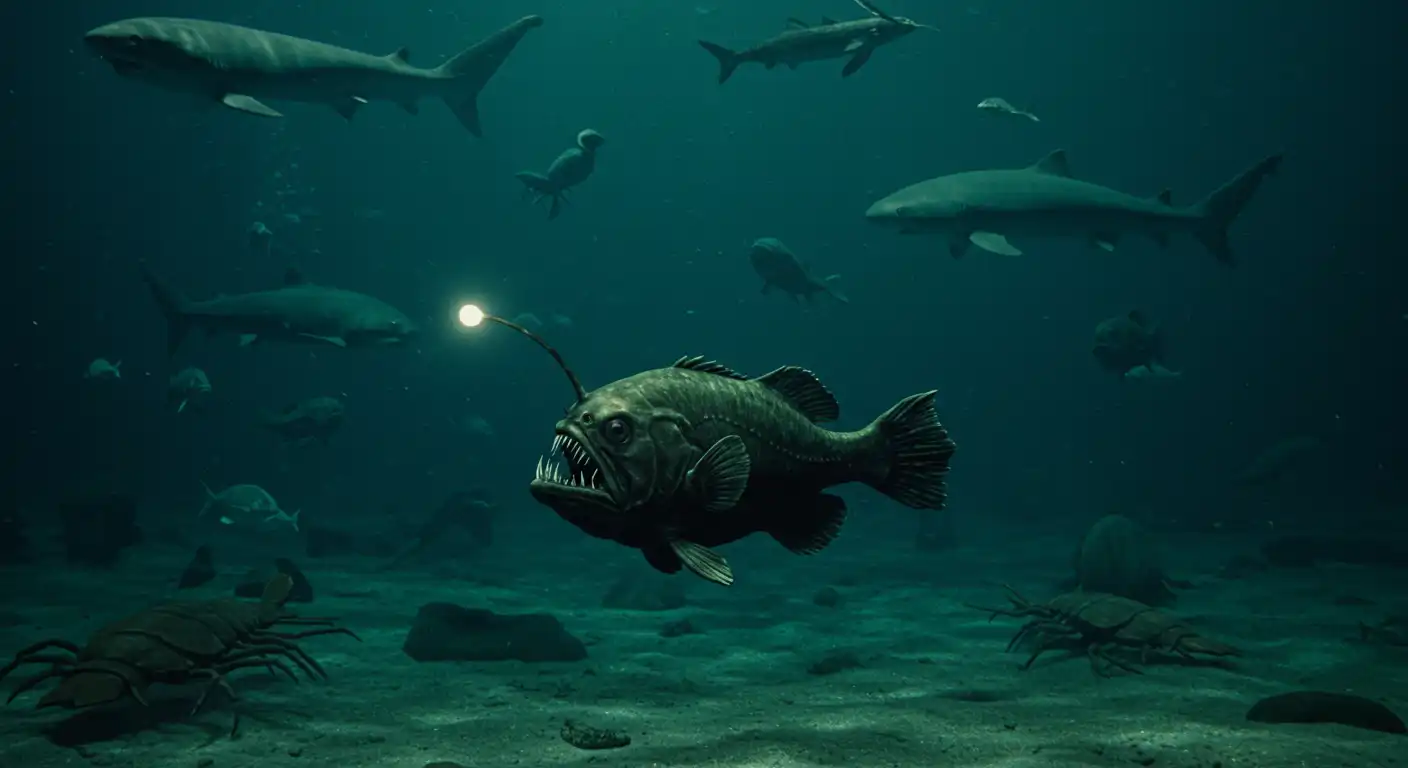Imagine swimming in pitch-black ocean depths, where pressure would crush a submarine and sunlight never shines. Suddenly, a strange flickering light appears in front of you. Intrigued, you move closer… and boom! A jaw full of needle-like teeth snaps shut. Welcome to the eerie world of the angler fish.
These bizarre creatures are straight out of a sci-fi horror flick, but they’re real—and their lives are even stranger than fiction. If you’ve ever wondered what an angler fish is, where it lives, or why it has a lightbulb hanging from its head, you’re in for a wild ride.
What Is an Angler Fish?
Angler fish are a group of deep-sea dwellers known for their bioluminescent lure and monstrous appearance. They belong to the order Lophiiformes and include over 200 known species. Most of them live in the abyssal or bathypelagic zones—depths beyond 3,000 feet.
The name “angler” comes from the way they hunt—using a built-in fishing rod-like appendage that dangles a glowing light to attract prey. Nature’s fishing pole, built-in!
Where Do Angler Fish Live?
You won’t find these guys near coral reefs or tropical shallows. Angler fish make their home in the deep sea, particularly in the Atlantic and Antarctic oceans. Some live more than a mile below the ocean surface, where pressure is intense, temperatures are near freezing, and food is scarce.
This harsh habitat has shaped nearly every weird trait angler fish possess—from their lighting system to their freaky mating habits.
What Do Angler Fish Look Like?
Let’s be honest—angler fish are not winning any beauty contests.
- Size: Most females are about 6 to 12 inches long, while males are much smaller (we’ll explain why soon).
- Body: Rounded and bony, with giant mouths and sharp, translucent teeth.
- Color: Usually dark brown or grayish-black to blend into the deep-sea darkness.
- Eyes: Small but adapted to low light.
- Lure (illicium): A thin rod-like extension from the head tipped with a glowing bulb (called the esca).
It’s like a cross between a nightmare and a glow stick.
The Bioluminescent Lure: How It Works
That glowing lure isn’t just for show—it’s a survival tool. Inside the esca, angler fish host symbiotic bioluminescent bacteria that produce light through chemical reactions. The light draws in smaller fish, squid, or crustaceans, who think it’s food—or something curious.
Once the prey gets close enough, the angler fish strikes with lightning speed, swallowing it whole. That’s dinner served deep-sea style.
Why Are Female Angler Fish So Much Bigger Than Males?
This is where it gets really weird.
Female angler fish are large and fearsome-looking because they do all the hunting and reproducing. Males? They’re tiny—sometimes only a few centimeters long—and their sole purpose is to find a female and mate.
But here’s the kicker: once a male finds a female, he latches onto her body with his teeth. Over time, his body fuses with hers—sharing her bloodstream and living as a permanent parasite. He loses his eyes, fins, and even organs, except for his testes. Romantic, right?
One female can carry multiple males like organic keychains. It’s bizarre biology at its finest.
What Do Angler Fish Eat?
Angler fish are opportunistic feeders. In the deep sea, meals are rare, so they eat whatever they can catch:
- Small fish
- Squid
- Shrimp
- Crustaceans
- Sometimes even other angler fish
Thanks to their expandable stomachs and flexible jaws, they can swallow prey nearly as big as themselves. When food is scarce, they can go weeks or even months without eating.
How Do Angler Fish Reproduce?
As mentioned, males permanently attach to females. Once fused, the male’s job is to provide sperm whenever the female needs it. This ensures that in a place where finding a mate is as hard as finding Wi-Fi in the desert, reproduction isn’t missed when the opportunity arises.
When conditions are right, the female releases thousands of eggs into the water. These eggs float near the surface before hatching into larvae, where they eventually sink deeper as they mature.
Are Angler Fish Dangerous to Humans?
Not at all. Despite their horrifying looks, angler fish pose no threat to humans. They live far too deep for divers to encounter them naturally, and their mouths, while scary, are only meant for catching small prey.
In fact, we probably pose more danger to them due to deep-sea trawling and pollution.
How Do Angler Fish Survive in Such Extreme Conditions?
Living in the deep sea is no joke, and angler fish have adapted like champs.
- Low metabolism: Helps them conserve energy between meals.
- Soft, gelatinous bodies: Withstand crushing pressure without needing strong skeletons.
- Dark coloration: Helps them stay camouflaged.
- Bioluminescence: Used for hunting and possibly communication.
These adaptations make them some of the most efficient predators in one of Earth’s most extreme environments.
Famous Types of Angler Fish
Not all angler fish are deep-sea monsters. Some are smaller, cuter, and even kept in aquariums (like the frogfish and monkfish). But here are a few infamous ones:
- Humpback angler fish: Known from viral deep-sea footage.
- Black sea devil: Features a terrifying appearance with a glowing lure.
- Fanfin angler: Has long, flowing appendages and a dramatic look.
Each species has its own twist on the classic angler design.
How Were Angler Fish Discovered?
Angler fish were first described in the 19th century when deep-sea exploration began. But it wasn’t until the late 20th and early 21st centuries—with the help of deep-diving submarines and ROVs (remotely operated vehicles)—that we started capturing footage of them in their natural habitats.
One of the most famous video clips came from the Monterey Bay Aquarium Research Institute, showing a female angler fish floating eerily in the deep with her glowing lure gently pulsing.
Are Angler Fish Endangered?
Currently, most angler fish species are not classified as endangered, mainly because we know so little about them. However, deep-sea fishing and environmental changes pose potential threats. Since they reproduce slowly and live in delicate ecosystems, any disruption can be risky.
Marine scientists agree: protecting the deep ocean means protecting creatures like the angler fish, even if we rarely see them.
Interesting Facts About Angler Fish
- Some angler fish can open their mouths wider than their own bodies.
- The lure can wiggle and pulse like real prey to trick animals.
- Some species have no light-producing lure and rely solely on ambush.
- The fused male-female pairing is one of nature’s weirdest reproductive strategies.
Why Are Angler Fish So Popular in Pop Culture?
Let’s face it—angler fish are creepy and fascinating. That combo makes them a hit in movies, video games, and books. Remember the glowing fish in Pixar’s Finding Nemo that chases Marlin and Dory? Yep, angler fish.
Their alien-like appearance has inspired everything from horror movie monsters to spooky Halloween decorations.
Conclusion
The angler fish is one of the ocean’s most mysterious and misunderstood creatures. With a built-in flashlight, a terrifying jawline, and a love life straight out of a sci-fi novel, it truly earns its place as one of nature’s strangest success stories.
Whether you find it fascinating or frightening, one thing’s certain—the angler fish is a shining (literally) example of how life adapts, even in the darkest places on Earth. So next time you think the ocean is all dolphins and coral reefs, just remember—somewhere down there, a glowing lure is flickering in the dark, waiting.





